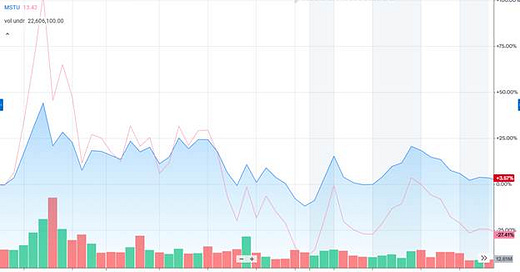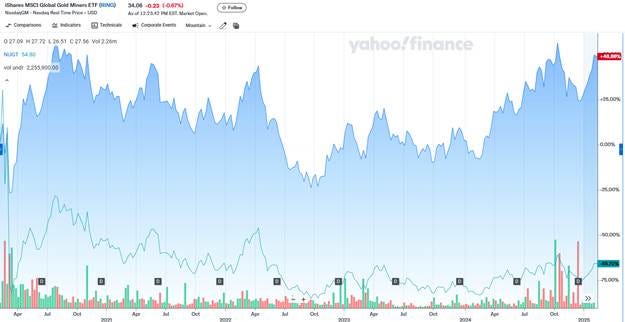Pigs get fat, hogs get slaughtered.
On November 15th, I wrote a note “This Is Not Investing” about the leveraged MicroStrategy ETF (MSTU), designed to provide two times the daily return of MicroStrategy stock (MSTR). By the end of January, MicroStrategy was up about 3.57%, and the leveraged ETF was down around 27.41%.
How is this possible?
Leveraged ETFs are not tools for long-term investors. They are tools for daily traders, and long-term returns often do not resemble the assets they are attempting to track. This is especially true for leveraged ETFs concentrated around a single asset.
The reason is “variance drain” or “volatility drag.”
It is a nerdy concept, but variance drain is the mathematical fact that an investment’s compounded return is always less than or equal to its simple average return. The gap between these returns widens with higher volatility.
In the case of MicroStrategy - an already incredibly volatile leveraged play on Bitcoin - adding additional leverage via an ETF will inevitably lead to a large amount of tracking error.
Why Is This Important?
Because a lot of investors don’t read the fine print, and leveraged ETFs are becoming increasingly popular.
According to this Bloomberg article, “Wall Street’s Levered ETF Boom Is Near-$1 Billion Money Spinner,” in 2024, six of the largest providers of leveraged ETFs made $940 million in revenue. That is a lot of money, and I’d guess that most of it didn’t come from day traders.
I’ve spoken with many investors who will say things like, “I think gold is going to do well under this administration.” And they bet on that idea by buying a leveraged gold fund. If you think gold will do well, why wouldn’t you want something that should do twice as well?
Sure, the warnings may say these products are for day traders, but why would you sell something every day just to buy it back again the next day?
So investors ignore the warnings, buy a leveraged ETF, hold it like they would an unleveraged ETF, and are surprised when things don’t go as planned.
For example, the below five-year chart compares a gold miner ETF (RING) with a 2x levered gold miner ETF (NUGT). Over five years, the unlevered holding was up 48%, while the levered ETF was down 65%.
The investor may have had the right idea, but things didn’t go as planned. That is usually what happens when you try to fight a math problem.
Personal note: Fort Bend Panthers lacrosse is back, and our third and fourth-graders are a force to be reckoned with.
And I may be biased, but I think our program has the best looking shooter shirts in the the league.









When it comes to writing about investments, the disclaimers are important. Past performance is not indicative of future returns, my opinions are not necessarily those of TSA Wealth Management and this is not intended to be personalized legal, accounting, or tax advice etc.
For additional disclaimers associated with TSA Wealth Management please visit https://tsawm.com/disclosure or find TSA Wealth Management's Form CRS at https://adviserinfo.sec.gov/firm/summary/323123
A TO-GO Order please - 1 dozen EXTRA-LARGE 💥sloppy piggies !